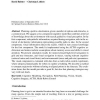Free Online Productivity Tools
i2Speak
i2Symbol
i2OCR
iTex2Img
iWeb2Print
iWeb2Shot
i2Type
iPdf2Split
iPdf2Merge
i2Bopomofo
i2Arabic
i2Style
i2Image
i2PDF
iLatex2Rtf
Sci2ools
CMOT
2010
2010
A cognitive model of spatial path-planning
Planning a path to a destination, given a number of options and obstacles, is a common task. We suggest a two-component cognitive model that combines retrieval of knowledge about the environment with search guided by visual perception. In the first component, subsymbolic information, acquired during navigation, aids in the retrieval of declarative information representing possible paths to take. In the second component, visual information directs the search, which in turn creates knowledge for the first component. The model is implemented using the ACT-R cognitive architecture and makes realistic assumptions about memory access and shifts in visual attention. We present simulation results for memory-based high-level navigation in grid and tree structures, and visual navigation in mazes, varying relevant cognitive (retrieval noise and visual finsts) and environmental (maze and path size) parameters. The visual component is evaluated with data from a multi-robot control experiment, where...
CMOT 2010 | Cognitive | Multi-robot Control | Visual |
Related Content
| Added | 01 Mar 2011 |
| Updated | 01 Mar 2011 |
| Type | Journal |
| Year | 2010 |
| Where | CMOT |
| Authors | David Reitter, Christian Lebiere |
Comments (0)

